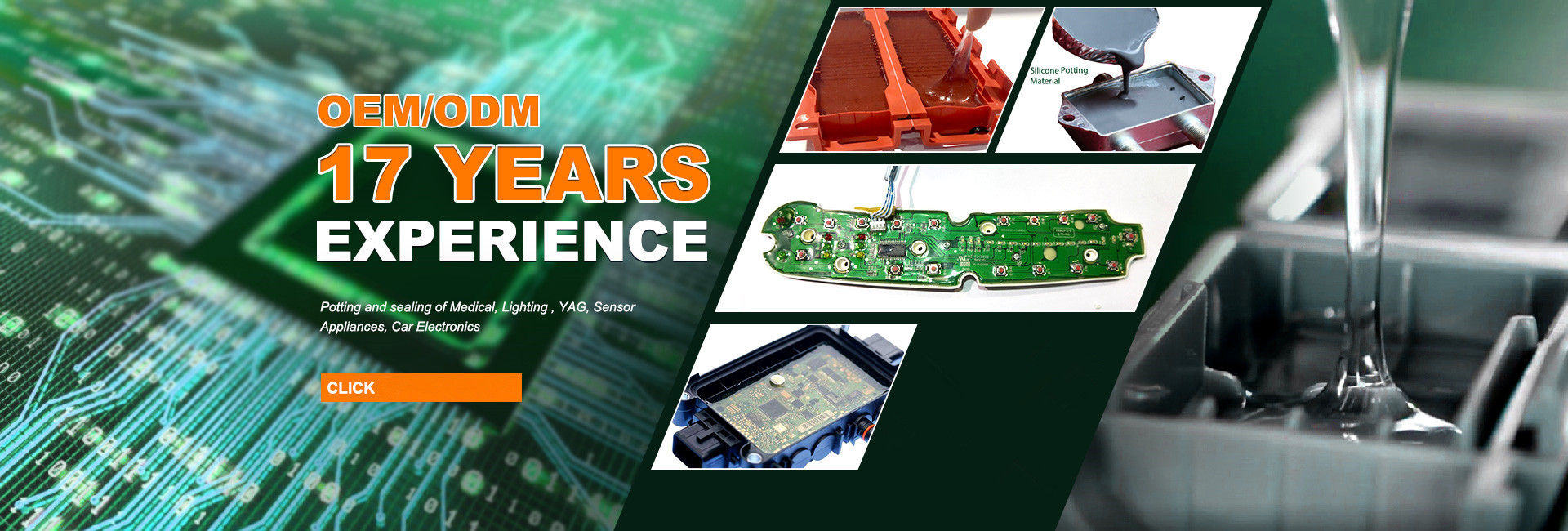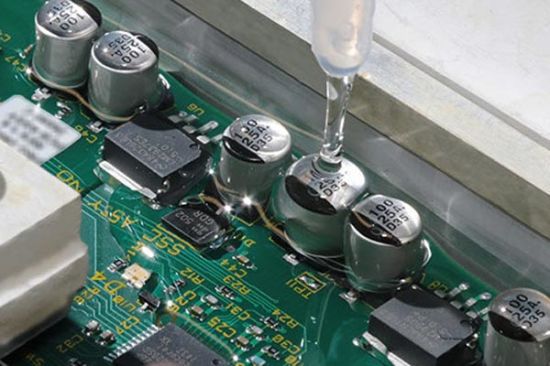
Chagel 6078 A/B Two components soft silicone gel
Fast mixing ( 1:1) and easy processing due to the low viscosity.
Room curing at normal.
Very fast curing kinetics a elevated temperature.
Adhere and elastic surface.
High tensile strength.
Color: Clear
Packaging: Part A:10kg, Part B:10kg,
Application: Used for encapsulation of various modules, semi-conductor, IGBT, automotive ECU module, IC chip, weighing sensor, waterproof connector.
Processing:
1. Mixing the two components
6078 A & B are mixed by weight in a fixed ratio given above.
The two components may be thoroughly mixed either by hand or using a low-speed electric or pneumatic mixer to minimise the introduction of air and to avoid any temperature increase.
Note: It is also possible to use a special mixing and dispensing machine for the two silicone components. Further information is available upon request.
2 . Handling
The mixture should be degassed preferably at 30 to 50 mbar to eliminate any entrapped air. If a dispensing machine is used, the two components are degassed separately prior to mixing.
The silicone mixture expands to 3 to 4 times of its initial volume and bubbles rise to the surface .The bubbles progressively disappear and the mixture returns to its initial volume after 2 to 3 minutes. Wait a few minutes to complete the degassing and then flash the vacuum. The silicone is ready for pouring, either by gravity or under low pressure.
Note: Flashing the vacuum once or twice accelerates the degassing. It is recommended to use a container with a high diameter/height ratio(3 to 4 times of the initial volume)
3 . Polymerisation
The system, as indicated in the technical data, polymerises at 25℃ .The curing may be slowed down at lower temperature and contrary accelerated by applying heat.Note: in general contact with certain materials can inhibit the crosslinking of RTV.
See list below:
Natural rubbers vulcanised with sulphur
RTV elastomers catalysed with metal salts,e.g. tin compounds
PVC stabilised with tin salts and additives
Epoxy catalysed with amines
Certain organic solvents, e.g.Ketones, alcohols, ether etc.
Components
| Part A | Part B | |
| Appearance | Low viscous liquid | Low viscous liquid |
| Color | Transparent | Transparent |
| Viscosity at 25℃ | Approx.1100 mPa.s | Approx.1200 mPa.s |
| Density at 25℃ | 0.99 g/cm3 | 0.99 g/cm3 |
Mixed components
| Mix ratio | A:B = 100:100 by volume |
| Viscosity after Mixing | Approx.1100 mPa.s |
| Potting life | 15±5 minutes at 25℃ |
| Cruing time | Max. 60minutes at 25℃ |
3 . Cured compound
Test at 25℃ after curing 7days at RT
| Appearance | transparent |
| Penetration,1/mm | 65 |
| Cone Penetration, ISO 2137 | 150g 35mm |
| Dielectric Strength,KV/mm | 25 |
| Volume Resistivity,Ω·cm | 1.0×1015 |
| Dielectric Constant at 1 MHz | 2.8 |
| Range of Using temperature | – 60 ∽ 260 ℃ |
Chagel 8078 Two components soft transparent silicone gel
Two component silicone elastomer that crosslinks at room temperature by polyaddition reaction.The pueolymerisation can be accelerated by heat ( max. 150℃ ).
Fast mixing ( 1:1) and easy processing due to the low viscosity.
Room curing at normal.
Very fast curing kinetics at elevated temperature.
Adhereand elastic surface
High tensile strength
Color: Clear
Packaging: Part A:10 KG, Part B:10 KG,
Application: The cured gel is used in some medical mattress, headrest, skin sticker, electric parts, IGBT module, junction box, auto control, and inverter.
Use:
1. Mixing the two components
BeGel 8708 A & B are mixed by weight in a fixed ratio given above.
The two components may be thoroughly mixed either by hand or using a low-speed electric or pneumatic mixer to minimise the introduction of air and to avoid any temperature increase.
Further information is available upon request.
2 . Handling
The mixture should be degassed preferably at 30 to 50 mbar to eliminate any entrapped air. If a dispensing machine is used, the two components are degassed separately prior to mixing.
The silicone mixture expands to 3 to 4 times of its initial volume and bubbles rise to the surface .The bubbles progressively disappear and the mixture returns to its initial volume after 2 to 3 minutes. Wait a few minutes to complete the degassing and then flash the vacuum. The silicone is ready for pouring, either by gravity or under low pressure.
| Appearance | transparent |
| Penetration,1/mm | 90 |
| Dielectric Strength,KV/mm | 25 |
| Volume Resistivity,Ω·cm | 1.0×1015 |
| Dielectric Constant at 1 MHz | 2.8 |
| Range of Using temperature | – 60 ∽ 260 ℃ |

Chagel 7078 A/B 1:1 Clear Two components soft silicone gel elastomer
Fast room temperature cure
Elastomer-like toughness
Protection from moisture, dirt, and other atmosphericcontaminants
Protection from mechanical stress and strain caused bythermomechanical shock and vibration
Easy repairability
Good dielectric properties, even at high frequencies
No solvents or cure by-products
Physical and electrical stability over a wide temperaturerange from -40° to 200°C
Color: Clear
Packaging: Part A:10 KG, Part B:10 KG,
Application: Used for semiconductor devices
Processing:
1. Mixing the two components
7078 A & B are mixed by weight in a fixed ratio given above.
The two components may be thoroughly mixed either by hand or using a low-speed electric or pneumatic mixer to minimise the introduction of air and to avoid any temperature increase.
Note: It is also possible to use a special mixing and dispensing machine for the two silicone components.Further information is available upon request.
2 . Handling
The mixture should be degassed preferably at 30 to 50 mbar to eliminate any entrapped air. If a dispensing machine is used, the two components are degassed separately prior to mixing.
The silicone mixture expands to 3 to 4 times of its initial volume and bubbles rise to the surface .The bubbles progressively disappear and the mixture returns to its initial volume after 2 to 3 minutes. Wait a few minutes to complete the degassing and then flash the vacuum. The silicone is ready for pouring, either by gravity or under low pressure.
Note: Flashing the vacuum once or twice accelerates the degassing. It is recommended to use a container with a high diameter/height ratio(3 to 4 times of the initial volume)
3 . Polymerisation
The system, as indicated in the technical data, polymerises at 25℃ .The curing may be slowed down at lower temperature and contrary accelerated by applying heat.Note: in general contact with certain materials can inhibit the crosslinking of RTV.
See list below:
Natural rubbers vulcanised with sulphur
RTV elastomers catalysed with metal salts,e.g. tin compounds
PVC stabilised with tin salts and additives
Epoxy catalysed with amines
Certain organic solvents, e.g.Ketones, alcohols, ether etc.
| Appearance | transparent |
| Hardness, Shore A | 6-8 |
| Cone Penetration, ISO 2137 | 150g 35mm |
| Dielectric Strength,KV/mm | 25 |
| Volume Resistivity,Ω·cm | 1.0×1015 |
| Dielectric Constant at 1 MHz | 2.8 |
| Range of Using temperature | – 60 ∽ 200 ℃ |
Chagel 5178 two-component transparent self-healing silicone potting gel
Two-component transparent self-healing silicone gel, after cured it will become quite elastic material with buffer and self-recovery. Used to isolate moisture and other noxious pollutant from contacting the circuit board, also used as dielectric of high voltage. The other usage is stress relief for protecting circuit and components from high temperature and mechanical stress.
1:1 addition type, good adhesive strength and self-healing
High elongation, excellent flexibility for mechanical stress relieving
Low oil penetration after cured, good anti-poisoningproperty
Good dielectric in high temperature for high voltage protection
Excellent aging resistance and weatherability
Excellent waterproof, corrosion prevention, moisture proof and chemical media resistance
Color: Clear
Packaging: Part A:10 KG, Part B:10 KG,
Application: Used for encapsulation of various modules, semi-conductor, IGBT, automotive ECU module, IC chip, weighing sensor, waterproof connector.
Use:
Mix Part A and Part B by 1:1 mass ratio, after evenly mixed, pouring directly into the components or modules as per requirements.
Still the potted component to let out the bubbles. It can be heat cured, about 30mins in 80°C. It needs about 4-5hours cured under room temperature. Require 24 hours to achieve surface without obvious oil layer.
Vacuum defoaming can improve the performance of cured product.
Seal the remaining products tightly after use.
Low temperature will slow the curing speed; heat curing is recommended.
| PROPERTY | STANDARD/UNITS | VALUE of 5178 | |
| —- | —- | PART A | PART B |
| Material | —- | Polysiloxane | Hydrogen polysiloxane |
| Color | Visual inspection | Colorless Liquid | Colorless Liquid |
| Viscosity | 25°C, cps | 800 | 700 |
| Density | 25°C, g/cm3 | 0.99 | 0.99 |
| Mixture/mass ratio | —- | A:B=100:100 | |
| Viscosity of mixture | 25°C, cps | 750 | |
| Operation time | 25°C, min | 60 | |
| Cure condition | —- | 25°C/24hour, 80°C/30min | |
| Cured appearance | —- | Transparent gel | |
| Needle penetration | 1/10 mm | 75 | |
| Application temperature | °C | -60~260 | |

Chagel 3068 High transparency liquid optical silicone gel
Two component, silicone elastomers which cures at room temperature by a polyaddition reaction. This reaction can be accelerated by heat.
Easy processing and curing.
Middle viscosity, easily mixing as 1:1 by weight or by volume.
Excellent transparency
High stability to ozone and ultraviolet light
High temperature stability
High stability and flexibility at low temperatures
Outstanding resistannce to aging and weathering
Low hardness, soft and flexible
Color: Clear
Packaging: Part A:5 KG, Part B:5 KG,
Application: Provide a glassy clear appearance to parts manufactured using it. The rubber is an evcellent candidate to consider for cost-efficient manufacture of highly transparent optical parts, with very low. Rain-light sensors, camera systems, opticalsensors
Use:
Mixing of the two components
Add 100 parts A to 100 parts B.
The two components may be intimately mixed either by hand or using a low-speed electric or pneumatic mixer to minimize the introduction of air into the mixture.
The viscosity of part A and B can be reduce using BESIL 2300, add 5 to 10% of the quantity of mixed gels . This will make no significant change to the mechanical properties after polymerization. Up to 30% of BESIL 2300 can be added without causing exudation.
Degassing
After mixing base and catalyst, it is recommended to eliminate entrapped air.
If the processing is done with the help of a machine both parts are degassed before mixing.
The gel is degassed under a vacuum of 30 to 50 mbar. Under vacuum, the product expands 3 at 4 times its initial volume and forms bubbles on its surface. These bubbles will disappear gradually and the mixture will sink back down to its initial volume. Wait a few minutes to ensure complete degassing and then release the vacuum. The product is ready for use
| Chagel 3068 | Part A | Part B | |
Appearance | Visual | Colorless Liquid viscous | Colorless Liquid viscous |
Viscosity(at 23°C, mPa.s, approx.) | GB/T 10247-2008 | 6000 | 6000 |
Specific gravity(at 23°C, g/cm3, approx.) | GB/T 15223-1994 | 0.99 | 0.99 |
Mix ratio(at 23°C, by weight) | 100:100 | ||
Mixed viscosity (at 23°C, mPa.s, approx.) | GB/T 10247-2008 | 6000 | |
Pot life(at 23°C, minutes, approx.) | 30 | ||
Hardness, Shore 00 | GB/T 531-2008 | 52±5 | |
Penetration | GB/T 269-1991 | 20±5 | |
Tensile strength, MPa | GB/T 528-2009 | 0.55 | |
Chagel 0528 high purity two component liquid silicone material for optical device modules
High purity two-component heat curing silicone materials. Resistance to environmental pollution, moisture, shock, vibration, etc., Maintain optical properties, mechanical properties and electrical properties in a wide range of temperature, humidity and harsh environmental conditions
High transparency
Excellent heat resistance
Long-term resistancetoUV-A and UV-B
No yellowing
Fast curing and rapid demold
Extremely accurate molding effect
Lighter than glass
Color: Clear
Packaging: Part A:10 KG, Part B:10 KG,
Application: Designed for the manufacture of optical device modules, and can be used for injection molding an optical lens and an optical wave guide coupling reduces scattering loss.
Use:
The substrate surface should be clean and dry. The substrate can be heated to remove surface moisture. Using naphtha, methyl ethyl ketoxime (MEK) or other suitable solvent to clean surface of the substrate. It should not use the solvent which dissolve or corrode to the substrate, should not use residual solvent.
Please keep accurate weigh to a clean glass container and mix thoroughly. When using high speed mixing equipment, heat will generate and the work time will reduce.
Under 10mmHg vacuum extrusion bubble. Usually prolapse bubbles before dispensing packaging material.
In most cases, the polysiloxane is suitable for working long hours at -45°Cto 200°C, the maximum short-term resistant to 350°C, the specific use, it is best to test the actual requirements.
Before the uncured material, containing not touch N \ P \ S and other organic matter, cannottouch Sn \ Pb \ Hg \ Bi \ As the ionic compound, etc., cannottouch the acetylene-containing \ active vinyl compound, peroxide cannot touch not touch the water gas and alcohols. These substances will hinder curing material reaches a certain concentration, the specific performance of three phenomena: the flow has been in a state completely cured, and the substrate base surface with thin fluid or in Las state, the contact surface and the substrate smiling bubbles. Fully test before use.
Should be cured by heating using a hot air oven ventilation to prevent the accumulation of trace amounts of hydrogen generated in the curing process to produce an explosion hazard.
Properties before curing | ||||
Property | Standard/Units | Chasil 0528 A | Chasil 0528 B | |
Ingredient | —- | Polysiloxane | Hydrogen polysiloxane | |
Appearance | Visual inspection | Colorless liquid | Colorless liquid | |
Viscosity | mPa·s (25°C) | 4000-6000 | 4000-6000 | |
Density | g/cm3 (25°C) | 0.99 | 0.99 | |
Mixing ratio | Mass ratio | A:B=100:100 | ||
Properties after curing | ||||
Hardness | shore A | 50 | ||
Tensile strength | MPa | 5.5 | ||
Light Transmission | 450nm@1mm,% | > 90 | ||
Volume resistance | ohm.cm | 2×1015 | ||





